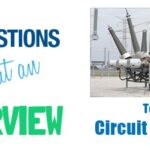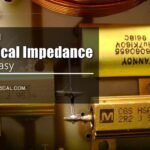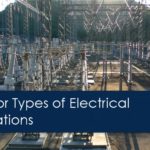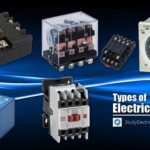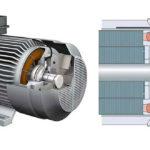Nervous about an upcoming Electrical Engineer interview? Check out this well-curated list of frequently asked Electrical interview questions and answers.
1. What is a 2 phase motor?
A two-phase motor is a motor with the starting winding and the running winding have a phase split. e.g;ac servo motor.where the auxiliary winding and the control winding have a phase split of 90 degrees.
2. What is ACSR cable and where we use it?
ACSR means Aluminium conductor steel reinforced, this conductor is used in transmission & distribution.
3. What will happen when the power factor is leading in the distribution of power?
If there is a high power factor, i.e if the power factor is close to one:
- Losses in the form of heat will be reduced,
- Cable becomes less bulky and easy to carry, and very cheap to afford, &
- It also reduces overheating of transformers.
4. Why Delta Star Transformers are used for Lighting Loads?
For lighting loads, the neutral conductor is must and hence the secondary must be star winding. and this lighting load is always unbalanced in all three phases.
To minimize the current unbalance in the primary we use delta winding in the primary. So delta/star transformer is used for lighting loads.
5. Why computer humming sound occurred in HT transmission line?
This computer humming sound is coming due to ionization (the breakdown of air into charged particles) of air around transmission conductor. This effect is called a Corona effect, and it is considered as power loss.
6. What is rated speed?
At the time of motor taking normal current (rated current)the speed of the motor is called rated speed. It is a speed at which any system take small current and give maximum efficiency.
7. If one lamp connects between two phases it will glow or not?
If the voltage between the two phases is equal to the lamp voltage then the lamp will glow.
When the voltage difference is big it will damage the lamp and when the difference is smaller the lamp will glow depending on the type of lamp.
8. What is Latching current?
Gate signal is to be applied to the thyristor to trigger the thyristor ON in safe mode.
When the thyristor starts conducting the forward current above the minimum value, called Latching current, the gate signal which is applied to trigger the device in no longer required to keep the SCR in ON position.
9. What is Holding current?
When SCR is conducting current in forward conduction state, SCR will return to forward blocking state when the anode current or forward current falls below a low level called Holding current
Note: Latching current and Holding current are not same. Latching current is associated with the turn-on process of the SCR whereas holding current is associated with the turn off process. In general, holding current will be slightly lesser than the latching current.
10. What is a Control System?
In a System the output and inputs are interrelated in such a manner that the output quantity or variable is controlled by input quantity, then such a system is called Control System.
The output quantity is called a controlled variable or response and the input quantity is called command signal or excitation.
11. What are the different types of Control Systems?
Two major types of Control Systems are
- Open-loop Control System
- Closed-Loop Control Systems
The Open-loop Control System is one in which the Output Quantity has no effect on the Input Quantity. No feedback is present from the output quantity to the input quantity for correction.
The Closed-loop Control System is one in which the feedback is provided from the Output quantity to the input quantity for the correction so as to maintain the desired output of the system.
12. What is the feedback in Control System?
The Feedback in Control System in one in which the output is sampled and the proportional signal is fed back to the input for automatic correction of the error ( any change in desired output) for further processing to get back the desired output.
13. Why Negative Feedback is preferred in the Control System?
The role of Feedback in the control system is to take the sampled output back to the input and compare the output signal with the input signal for error ( deviation from the desired result).
Negative Feedback results in the better stability of the system and rejects any disturbance signals and is less sensitive to the parameter variations. Hence in control systems, negative feedback is considered.
14. What is the advantage of a freewheeling diode in a Full Wave rectifier?
It reduces the harmonics and it also reduces sparking and arching across the mechanical switch so that it reduces the voltage spike seen in an inductive load.
15. Mention the methods for starting an induction motor?
The different methods of starting an induction motor:
- DOL: direct online starter
- Star delta starter
- Autotransformer starter
- Resistance starter
- Series reactor starter
16. What is the power factor of an alternator at no load?
At no load Synchronous Impedance of the alternator is responsible for creating angle difference. So it should be zero lagging like an inductor.
17. What is the function of anti-pumping in circuit breaker?
When the breaker is close at one time by close push button, the anti pumping contactor prevents reclose the breaker by close push button after if it already close.
18. What is a stepper motor? what are its uses?
Stepper motor is the electrical machine which act upon input pulse applied to it. it is one type of synchronous motor which runs in steps in either direction instead of running in complete cycle.so, in automation parts it is used.
19. There are a Transformer and an induction machine. Those two have the same supply. For which device the load current will be maximum? And why?
The motor has max load current compare to that of the transformer because the motor consumes real power.. and the transformer is only producing the working flux and it is not consuming. Hence the load current in the transformer is because of core loss so it is minimum.
20. What is the difference between MCB & MCCB, Where it can be used?
MCB is a miniature circuit breaker which is thermal operated and uses for short circuit protection in small current rating circuit.
MCCB molded case circuit breaker and is thermal operated for overload current and magnetic operation for instant trip in short circuit condition, under-voltage and under frequency may be inbuilt. Normally it is used where normal current is more than 100A.
21. Where should the lighting arrestor be placed in distribution lines?
Lightning Arresters are placed near distribution transformers and outgoing feeders of 11kv and incoming feeder of 33kv and near power transformers in sub-stations.
22. Define IDMT relay?
It is an inverse definite minimum time relay. In IDMT relay its operating is inversely proportional and also a characteristic of minimum time after which this relay operates. It is inverse in the sense, the tripping time will decrease as the magnitude of fault current increase.
23. Two bulbs of 100w and 40w respectively connected in series across a 230v supply which bulb will glow bright and why?
Since two bulbs are in series they will get an equal amount of electrical current but as the supply voltage is constant across the bulb(P=V^2/R).
So the resistance of 40W bulb is greater and the voltage across 40W is more (V=IR) so 40W bulb will glow brighter.
24. Why temperature rise test is conducted in bus bars and isolators?
Bus bars and isolators are rated for continuous power flow, that means they carry heavy currents which rise their temperature. So it is necessary to test these devices for temperature rise.
25. Difference between a four-point starter and three-point starter?
The shunt connection in the four-point starter is provided separately from the line whereas in three-point stater it is connected with a line which is the drawback in three-point stater
26. Whats is MARX CIRCUIT?
It is used with generators for charging a number of the capacitor in parallel and discharging them in series. It is used when the voltage required for testing is higher than the available.
27. Why we can’t store AC in Batteries instead of DC or Can we store AC in batteries instead of DC?
We cannot store AC in batteries because AC changes their polarity upto 50 (When frequency = 50 Hz) or 60 (When frequency = 60 Hz) times in a second. Therefore the battery terminals keep changing Positive (+ve) becomes Negative (-Ve) and vice versa, but the battery cannot change their terminals with the same speed so that’s why we can’t store AC| in Batteries.
Also when we connect a battery with AC Supply, then it will charge during the positive half cycle and discharge during negative half cycle because the Positive (+ve) half cycle cancel the negative (-Ve) half-cycle, so the average voltage or current in a complete cycle is Zero. So there is no chance to store AC in the Batteries.
Also, note that Average Voltage x Average Current ≠ Average Power.
28. Will a DC Shunt Motor operate on an A.C Supply?
The Shunt winding has a large number of turns so that it has appreciable inductance. When A.C is applied to a shunt motor, the large inductive reactance of shunt winding will reduce the field current too much. Consequently, Shunt motor will not usually run on A.C Supply.
29. What is the difference between Power Transformers and Distribution Transformers?
Those transformers installed at the ending or receiving end of long high voltage transmission lines are the power transformers. The distribution transformers (generally pole mounted) are those installed in the location of the city to provide utilization voltage at the consumer terminals.
- Power transformers are used in transmission network of higher voltages for step-up and step down the application (400 kV, 200 kV, 110 kV, 66 kV, 33kV) and are generally rated above 200MVA.
- Distribution transformers are used for lower voltage distribution networks as a means to end user connectivity. (11kV, 6.6 kV, 3.3 kV, 440V, 230V) and are generally rated less than 200 MVA.
- A power transformer usually has one primary and one secondary, and one input and output. A distribution transformer may have one primary and one divided or “Tapped” secondary, or two or more secondaries.
- Power transformers generally operate at nearly full – load. However, a distribution transformer operates at light loads during major parts of the day.
- The performance of the power transformers is generally judged from commercial efficiency whereas the performance of a distribution transformer is judged from all-day efficiency.
- The rating of a high transformer is many times greater than that of distribution transformer.
- In Power Transformer the flux density is higher than the distribution transformer.
- Power transformer’s primary winding always connected in star and secondary winding in delta while in distribution transformer primary winding connected in delta and secondary in star.
- In the Substation end of the transmission line, The Power Transformer Connection is Star-Delta.( For the purpose of Step down the Voltage Level)


